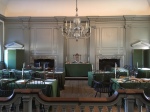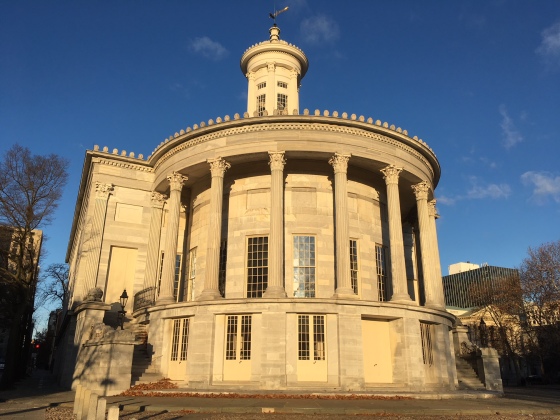Happy New Year, everyone! Things are starting to get back to normal at the Olmsted Center after the holidays as the snow outside from the recent “bomb cyclone” begins to melt during a little 30+ degree heat wave we’re having in Boston. I’m now the only intern left from our merry band of summer interns, but I’m very happy to report that my internship has been extended, and I’ll be sticking around for a few more months to continue my work with the CRSAs for parks in the region. There are a lot of fascinating new projects ahead for OCLP in 2018, but I want to take us back to 2017 briefly for today’s post. Before the holidays, Bob Page, Director of the Olmsted Center, and I had the privilege of taking a trip down to Philadelphia to complete one of the last steps before we finish the CRSA for Independence National Historical Park: a meeting with the full team of staff who have been part of the effort to assess the current conditions and program health of cultural resources at Independence National Historical Park. After months of trading emails and conducting hours of phone calls with park and regional archaeologists, historic architects, landscape architects, ethnographers, museum specialists, historians, archivists, etc., it was so exciting to finally meet this very skilled and knowledgeable group of people face-to-face. During our meeting, the team had a chance to review the findings of the assessment and discuss broad management topics that affect all cultural resource types, such as Section 106 compliance, GIS (Geographic Information Systems), NAGPRA compliance (Native American Graves Repatriation Act), and climate stressors. Perhaps the most important result of our efforts was being able to work with this multidisciplinary team to determine several priority actions for the park to pursue in the months and years ahead based on areas of need we had identified. Prior to our meeting, I also had the opportunity to spend a full day exploring the park. The park’s Chief of Cultural Resources, Doris Fanelli, organized a full day of activities and meetings for me, starting with a private tour of the Bishop White House and the portrait gallery housed inside the Second Bank of the United States. Although the temperatures had dropped down to the teens outside, there were some definite perks of visiting the park on a cold, winter day: there were only 11 people on the usually crowded tour of Independence Hall, and I got to enjoy a private visit of Congress Hall when no one else turned up for the normally scheduled talk. From there, I explored many of the other sites that were open to the public, including Congress Hall, Old City Hall, Carpenter’s Hall, and Franklin Court. Independence Square The Second Bank of the United States Inside the Bishop White House The Assembly Room inside Independence Hall From there, I was treated to an “insider” view of the park, as Doris had scheduled me to meet with several members of the park staff. First, I got to sit down with Andrew McDougall, the park’s special event coordinator. I wrote my master’s dissertation on the use of historic buildings and sites as filming locations (Read a summary here), so I was particularly interested in talking to Andrew about his experiences coordinating special use permits for filming activity in the park. Next, I visited the architectural study collection with Museum Specialist Nicole Altman. Coming from a background in architectural conservation, I was fascinated by this treasure trove of original fragments from buildings in the park as well as molds and reproductions that have been used in restoration work. Lastly, Nicole and I met with the park’s historical architect, Winston Clement, who helped us end the day on a few literal high notes. He first took us up the tower of the Merchant’s Exchange Building. Originally built between 1832 and 1843, the magnificent Greek Revival building was the financial center for Philadelphia in the 19th century, housing commercial houses, marine insurance companies, the Philadelphia Board of Trade, and the Philadelphia Stock Exchange. Merchants would climb its tower to watch ships come in. During our visit, we were able to enjoy the same view and observe the tower’s unique construction and internal bracing. While that was an unforgettable experience by itself, the best was certainly saved for last: a trip up the bell tower of Independence Hall. The tower has been demolished, altered, and restored a number of times since the building was originally constructed between 1732 and 1753. From inside, we could see physical traces of the many phases of its life and view the mechanisms that operate the clocks on its exterior. Our visit was perfectly timed to fully experience this ingenious piece of engineering. As the sun set and the clock struck 5 o’clock, the clock mechanism sprang to life, and with the whirring of gears and chiming of bells, I said goodbye to Winston and a magical day at Independence National Historical Park.
The Independence Hall bell tower The clock mechanism inside the tower of Independence Hall
|





 Merchant’s Exchange Building
Merchant’s Exchange Building
